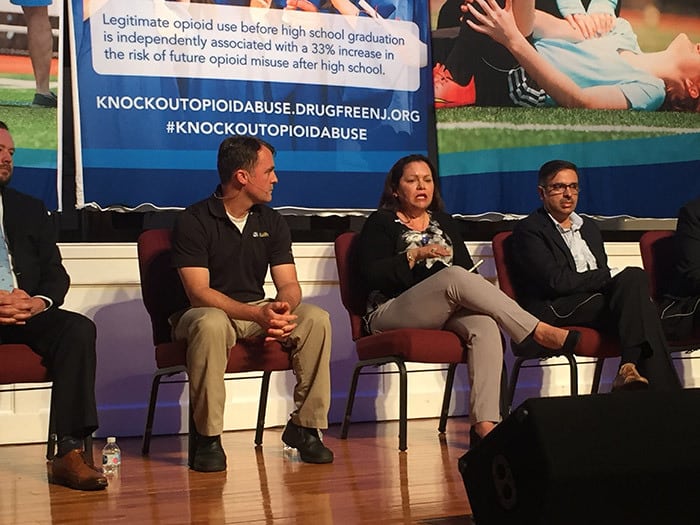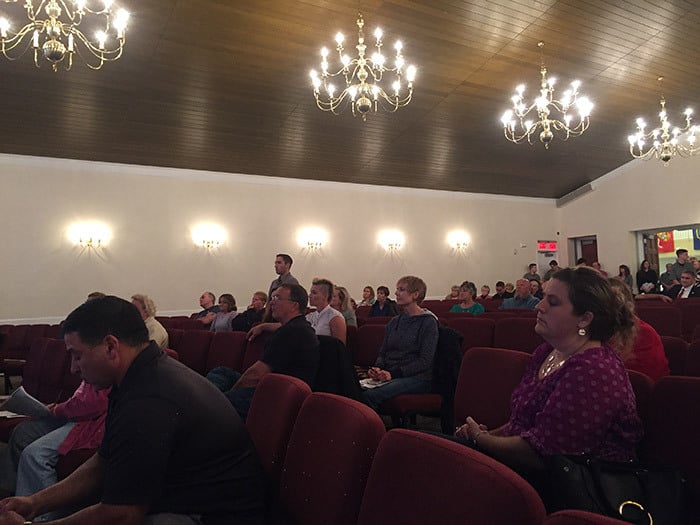
LITTLE EGG HARBOR – Ocean County officials, experts, and nearly 100 concerned residents gathered at the Cavalry Baptist Church in Little Egg Harbor to create a deeper dialogue around the ever-growing opioid epidemic in New Jersey.
The program, called “Knock Out Opioid Abuse: A Town Hall Series” was the 18th out of 20 town hall discussions to be held throughout New Jersey. It generated conversation around the devastating statistics associated with the epidemic, prevention tactics, and various resources for recovery to try and provide a new way of looking at the issue.
Rebecca Alfaro, deputy director of the Governor’s Council on Alcoholism and Drug Abuse and moderator at the event, noted that the purpose of the panel was to brainstorm on “how can we heal as a community and how can we prevent this from continuing to happen?”
“There is not a day that goes by without hearing or seeing a story in our neighborhood or in the media on the impact of the misuse of prescription medication or heroin abuse,” said Alfaro. “Ocean County is not immune. No family or community is immune.”
The discussion brought to light some alarming statistics and heart-wrenching personal encounters with opioid addiction as the series’ five panelists each took a turn at the mic to share their perspectives.
Ocean County Prosecutor Joseph Coronato remarked that his usual approach to the opioid crisis is comprised of three “pillars.” These are education and prevention, strong law enforcement, and most importantly, breaking the cycle of addiction.
“We were the first county in the state of New Jersey to use Narcan,” said Coronato, in reference to the chemical nasal spray that can potentially reverse an overdose and save a life. “We had 129 deployments in 2014, in 2015 we had 272, in 2016 we went up to 502, and then…went down from 502 to 341 in 2017 and as of this date we’re at about 135.”

From 2014 to 2016, overdose deaths went up from 112 to 216. However in 2017, the number went down to 166. “I’m very proud of that” 25 percent reduction in overdose deaths, said Coronato.
Not only this, but Coronato drew attention to the serious rise in fentanyl use noting that by 2017, 65 percent of overdose victims had fentanyl in their systems. “Fentanyl is a game changer.”
As we can see from these statistics, the opioid crisis is not going away any time soon. Coronato explained that breaking the cycle of addiction is the number one priority now when it comes to tackling the epidemic. Programs like the Opioid Overdose Response program, established in 2016, and Blue HART, established in 2017, have made strides in helping addicts recover and heal before an overdose takes place.
Blue HART (Heroin, Addiction Response Team) allows addicts to walk into their local participating police station and turn in their drugs in exchange for recovery assistance. Ocean County towns including Lacey, Ocean Gate, Stafford, Little Egg Harbor, Point Pleasant Borough, Manchester and Brick all participate in the Blue HART program. Coronato noted that Surf City on Long Beach Island is the newest addition to the program.
“It’s not just impacting the patient,” said Dr. Muhammad Abbas, Chief of Addiction Medicine and Medical Director of Partial Hospital Program at Jersey Shore University Medical Center. Abbas provided the panel of experts with a public health perspective, remarking that opioid abuse not only affects the patient but also the family, and society as a whole.
Abbas said that the problem has a significant impact on the medical sector, when you think about the amount of hospital beds or emergency room resources addicts require in an overdose situation, saying “this is the time to be dealing with this.”

Michael Capko, DART Coalition Manager echoed these sentiments when he discussed some of the barriers people face when attempting to get treatment. Capko explained that, across the board, it is usually insurance issues and cost that became a barrier for many seeking treatment. The gap between those who are uninsured or have Medicaid, and those facilities that will treat them is significant, which is a huge issue that still needs fixing when it comes to improving the way we help addicts.
“I think the one of the biggest things that we can do in this field is to advocate and support all aspects of the continuum, so from prevention to treatment and recovery support services,” he added.
“This is a disease that we’re talking about, and sometimes diseases are treated with medication and sometimes they are treated with other preventative measures,” said Alfaro.
As Alfaro said, one way to deal with opioid abuse is prevention. This is the most important step in handling opioid abuse, according to Liza DeJesus, director of prevention services at Prevention First.
“Prevention is the first stop to addressing this epidemic,” said DeJesus. “We plant the seed of hope…we let the children know what it is that they can do to prevent them from growing up to be addicted.”
The way this is done is through evidence based curriculum and prevention strategies within schools and communities. DeJesus noted that Prevention First starts teaching kids about prevention as young as pre-kindergarten.
“Self-esteem, showing them how to make healthy decisions, helping them through the process of decision making, making them confident children, believing in themselves; all of these things lead up to a resilient child,” she said.
DeJesus emphasized that it is important to have a continuous conversation with children as they grow up. “The younger we start, the more they get the message.”
Another important aspect that makes prevention an ideal alternative is that prevention strategies are less expensive than recover treatment, according to DeJesus.
“For every dollar that’s spent in prevention, there are up to $20 spent in treatment,” said DeJesus. “It affects all of us.”

Another panelist, Pastor Mike Dellaperute of the Cavalry Baptist Church, discussed what he considers to be the biggest barriers to dealing with addiction.
“There are many barriers to getting help…drugs are an idol and they require a sacrifice,” he said.
Dellaperute’s first barrier is that it is impossible to trust an addict, and the second is that sometimes we are the barrier when we act as enablers.
“The most loving thing you can do for them [addicts] is make it as difficult as possible for them to continue in their lifestyle,” he explained.
The town hall program brought forth a lot of new information and provided some hope to the public that Ocean County officials are working tirelessly to fight the opioid epidemic every day. Officials emphasized that the goal is to nip the problem in the bud so that we can prevent people from becoming addicts and eradicate the problem before it even starts.
Coronato noted that frequently used medications for treatment such as methadone, vivtrol, and suboxone, are not cures, but rather “just cure the craving.” This is what Coronato believes we need to avoid and we can start by helping addicts with law enforcement systems, as opposed to through them.
This, and sustainable recovery, are the goals, according to officials.






